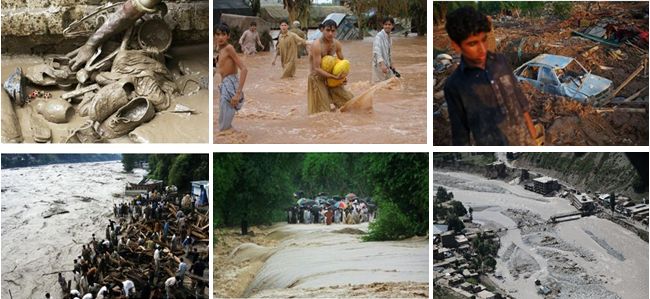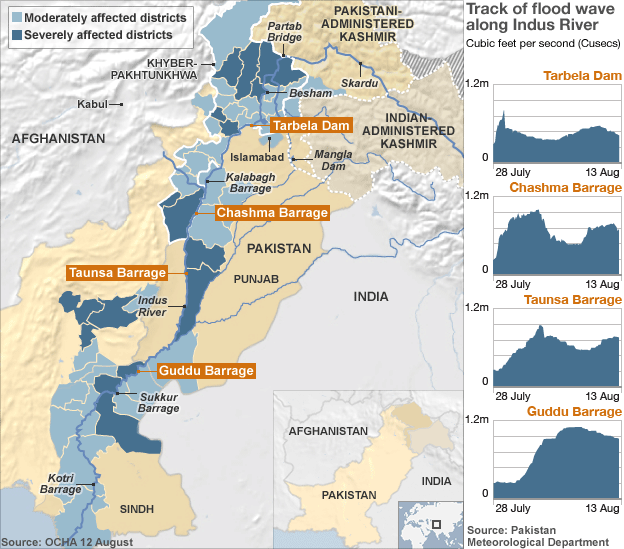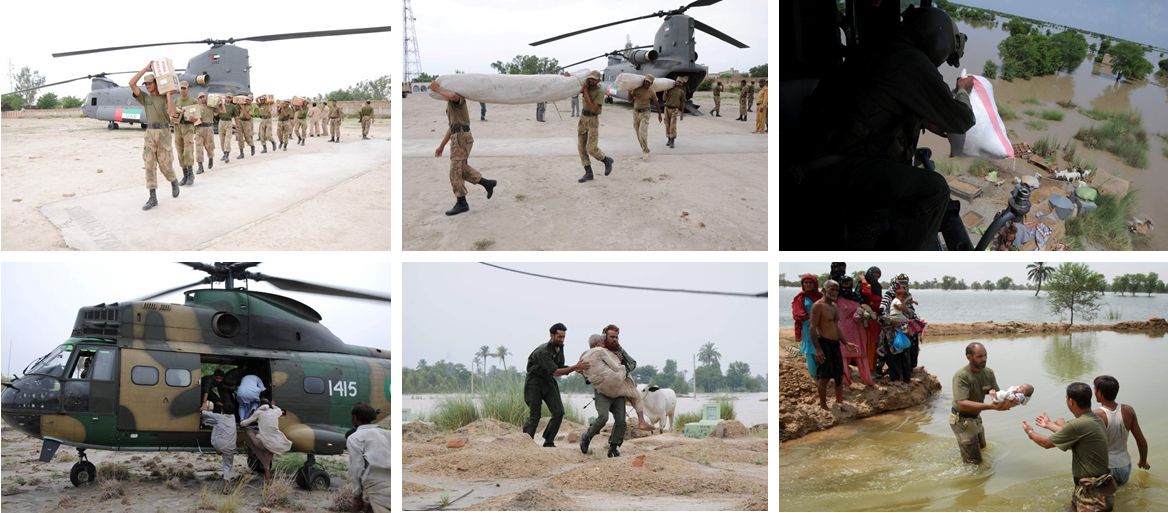

Floods 2010

The worst floods of the century in Pakistan
 |
Pakistan has had hardly recovered from the devastating earthquake of it history that struck its northern areas in 2005, that yet another calamity, much larger in magnitude hit Pakistan in July-August 2010. This time it was flash flood - floods that have never been witnessed or heard in the last 80-100 years in this part of the world. Although, there were indications of heavy monsoons this year, but keeping in view the rather dormant monsoon seasons over the past few years, the warning went rather unnoticed. And then the rains came. It started with the province of Balochistan, where rains, that came with the Cyclone Yemyin (03B), swelled the water courses with very fast currents, which swept away roads, mud houses and made countless homeless. While the local administrations and the government was tackling with the floods there, torrential rains hit the northern areas of Pakistan. The ferocity of the rains was so intense, that it broke all previous records. The unending rains caused the Munda Dam in the Swat Valley to overflow and later got damaged. This caused floods in the Swat Valley and adjoining areas. One can only see the video to know the intense speed of the muddy flood water. The rivers over flew and water gushed in from everywhere. The water entered the city of Bahrain, a tourist haven, and washed away the main bazaar along with some over 300 shops. Goods worth millions of rupees was also washed away. A large number of bridges made on gorges and rivers were also washed away, cutting all lines of communication with the upper areas, marooning a large number of helpless people. As if this wasn't enough. The Kabul River also swelled and ran into very high floods. and soon it hit the old garrison city of Nowshehra. Nowshehra is an old city with congested bazaars and shopping areas. Most of the business is run by the cloth merchants, who have shops in basements besides on main roads. The flood water not only entered the shops on main roads, but filled up the basements. It swept away the cloth costing millions beside rendering many around Nowshehra homeless. The mud houses in villages around the city were washed away and those which remained have been severely damaged beyond repairs (map left shows extent of damage by swollen Indus - courtesy BBC ) |
The flood waters then joined the River Indus, which was otherwise flowing in high floods and the roaring muddied flood moved towards its next victim - the Dera Ghazi Khan in the Punjab province. Since there haven't been any floods over the years, poor farmers with no lands had cultivated the land inside the dry bed of the river and had built homes. They were the first prey to the flood as the fast currents washed away everything that came its way. The flood continued down stream, eating away anything that came its way. Standing crops, mud houses and livestock were badly hit. Millions became homeless and ran away to safer places leaving all their lifetime belongings at the mercy of the flood water.
The protective bunds along the Indus gave away one after the other, inundating vast farmlands and villages and towns. Most of the bunds gave in to the extreme pressure of the flood water, while at many places, the bunds were deliberately breached to save larger cities and towns.
The water flows further south in the Sind province with much more speed and is causing more and more damage. The water discharge at a number of barrages built on the Indus River exceeded one million cusecs, that even threatened the decades old barrages. Balochistan which had faced the brunt in its initial phase, was subjected to more devastation when the broken bunds also caused flood water to enter the towns and villages adjoining the Sind province. At one stage the PAF base Shahbaz was also threatened. The towns of Sukkur, Shikarpur, larkana in Sind and Dera Murad Jamali in Balochistan are the worst hit. at the time of writing this post, the water still continues downstream with much more momentum and ferocity - bringing more damage and destruction to life and property.
As per the estimates of the United Nations, the number of people suffering from the massive floods in Pakistan exceeds 20 million — more than the combined total of the 2004 Indian Ocean tsunami, the 2005 Kashmir earthquake and the 2010 Haiti earthquake. The total number of people affected in the three other disasters was about 11 million — 5 million in the tsunami and 3 million in each of the earthquakes. "The magnitude of the tragedy is so immense that it is hard to assess," said Pakistan's prime minister during a visit to the central Pakistani city of Multan. So far about 1500 people have succumbed to these deadly muddy waters, besides millions of animals and livestock. an area roughly 160,000 square kilometers has been affected by the floods. As per initial estimates structural damages are estimated to exceed $ 4 billion, and wheat crop damages are estimated to be over $ 500 million and the figures are rising as the water continues to engulf more and more lands downstream Indus.
Even after many days, rescue workers have been unable to reach up to 600,000 people marooned in the Khyber Pakhtunkhwa (KPK) province's Swat Valley, where many residents were still trying to recover from last year's fight with the Taliban. Bad weather has prevented helicopters from flying to the area, which is inaccessible by ground. The plight of those who have survived is pathetic. The country's resources are far inadequate to handle devastation of such magnitude. Affected people lie in utter misery under the open sun, while a few lucky get shelter and food. One of the surviving victim lamented, "It would have been better if we had died in the floods as our current miserable life is much more painful." An old woman lamented, ''I have no utensils and no food for my children. I have no money. We were able to escape the floodwaters, but hunger may kill us.''
Now a few words about the rescue and relief operations. Right from the onset, the civil administration found it much beyond its capacity to handle this disaster. had it not been for the timely rescue operations by the Pakistan army, which was later joined by Pakistan Air Force and the Pakistan Navy, the people would have suffered much more and the casualties would have been unimaginable. The helicopters of army, navy and air force flew round the clock to rescue people who had found shelter on roof tops or high grounds. Where army helicopters and military could not go due to bad weather and inaccessibility of the northern areas, the army is using its mules to reach out to the marooned people.

The international relief effort so far has been woefully inadequate. Even the reaction of the international community to this one of the greatest disasters has been dismal and poor. While the immediate relief support in the form of tents, medicines and food items will ease some of the sufferings of the people, it would be the rehabilitation of the flood victims that would see the true test of humanity. Over a million houses need to be rebuilt from the scratch, thousands of kiolometers of roads and railway tracks will have to be re-laid. Countless number of bridges will have to be rebuilt while a large number of protective bunds will require plugging. There is an outbreak of water borne diseases and already dozens of children and women have died due to diseases like gastro. There are many pregnant women who need special care and attention right in the field.
The poor victims wait and see what the government of Pakistan with the help of international community does for their rehabilitation - they are keeping their fingers crossed as after a calamity is over, all is forgotten and no one really heals the wounds of the affected people who ultimately have to start afresh on their own to continue living once again - if you can call it living...
|
Related Sites: | Pakistan Flood - Two major peaks due on Indus (BBC) | 2010 Floods Pakistan (Wikipedia) | Donate for flood victims of Pakistan (Pakistan Army) | |
|
| HOME PAGE | Copyrights © JalalsPages - 2010 |